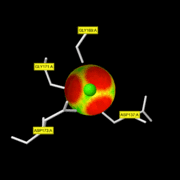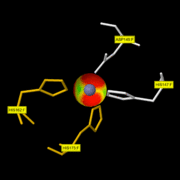Sandbox Reserved 1125
From Proteopedia
(Difference between revisions)
| Line 47: | Line 47: | ||
The Zn ion which is involved in the catalytic activity is the Zn999. In a publication (http://www.ncbi.nlm.nih.gov/pmc/articles/PMC394940/?page=2) which studies the catalytic domain of MMP8 thanks to the Pro-Leu-Gly-hydroxylamine inhibitor, this ion is penta-coordinated with: His197, His201 and His207 of MMP8 and with the carbonyl and the hydroxyl oxygen of the hydroxamic acid moiety of the inhibitor. | The Zn ion which is involved in the catalytic activity is the Zn999. In a publication (http://www.ncbi.nlm.nih.gov/pmc/articles/PMC394940/?page=2) which studies the catalytic domain of MMP8 thanks to the Pro-Leu-Gly-hydroxylamine inhibitor, this ion is penta-coordinated with: His197, His201 and His207 of MMP8 and with the carbonyl and the hydroxyl oxygen of the hydroxamic acid moiety of the inhibitor. | ||
[[Image:ZN pocket interaction.gif | thumb|ZN pocket interaction]] | [[Image:ZN pocket interaction.gif | thumb|ZN pocket interaction]] | ||
| - | The residues involved in the Zn interactions are one Asp residue (149) next to three His residues (147, 162 and 175). | + | The residues involved in the Zn interactions are one <scene name='71/719866/Zn998/1'>Asp residue (149) next to three His residues (147, 162 and 175)</scene>. |
This enzyme binds 2ZN ions per subunit. | This enzyme binds 2ZN ions per subunit. | ||
<font color='red'>maintain a Zn2+ atom coordinated with three water molecules. One of them is as well bound to the Glu residue thanks to a hydrogen bond. The second Zn2+ atom is not involved in the active site. At first, the Gly 206 residue of the substrate binds the active site thanks to the Zn2+ atom. When it binds it takes the place of unstable water molecules and establishes stabilizing interactions with the active site thanks to its C terminal part. Then, the Ala 182 residue of the enzyme makes a hydrogen bond with the NH group of the substrate: this allows the substrate to enter the cavity of the catalytic site. The rest of the protein is stabilized by 4 hydrogen bonds with the amino acid located in the cavity.</font> | <font color='red'>maintain a Zn2+ atom coordinated with three water molecules. One of them is as well bound to the Glu residue thanks to a hydrogen bond. The second Zn2+ atom is not involved in the active site. At first, the Gly 206 residue of the substrate binds the active site thanks to the Zn2+ atom. When it binds it takes the place of unstable water molecules and establishes stabilizing interactions with the active site thanks to its C terminal part. Then, the Ala 182 residue of the enzyme makes a hydrogen bond with the NH group of the substrate: this allows the substrate to enter the cavity of the catalytic site. The rest of the protein is stabilized by 4 hydrogen bonds with the amino acid located in the cavity.</font> | ||
Revision as of 15:31, 28 January 2016
MMP8
MMP-8, also called, Neutrophil collagenase or Collagenase 2, is a zinc-dependent and calcium-dependent enzyme. It belongs to the matrix metalloproteinase (MMP) family which is involved in the breakdown of extracellular matrix in embryonic development, reproduction, and tissue remodeling, as well as in disease processes, such as arthritis and metastasis. The gene coding this family is localized on the chromosome 11 of Homo sapiens .[1]
| |||||||||||
References
- ↑ "MMP8 matrix metallopeptidase 8 (neutrophil collagenase)"
- ↑ Stams T, Spurlino JC, Smith DL, Wahl RC, Ho TF, Qoronfleh MW, Banks TM, Rubin B. Structure of human neutrophil collagenase reveals large S1' specificity pocket. Nat Struct Biol. 1994 Feb;1(2):119-23. PMID:7656015
- ↑ 3.0 3.1 Substrate specificity of MMPs
- ↑ Hirose T, Patterson C, Pourmotabbed T, Mainardi CL, Hasty KA. Structure-function relationship of human neutrophil collagenase: identification of regions responsible for substrate specificity and general proteinase activity. Proc Natl Acad Sci U S A. 1993 Apr 1;90(7):2569-73. PMID:8464863
- ↑ Knauper V, Osthues A, DeClerck YA, Langley KE, Blaser J, Tschesche H. Fragmentation of human polymorphonuclear-leucocyte collagenase. Biochem J. 1993 May 1;291 ( Pt 3):847-54. PMID:8489511
- ↑ Welgus HG, Jeffrey JJ, Eisen AZ. Human skin fibroblast collagenase. Assessment of activation energy and deuterium isotope effect with collagenous substrates. J Biol Chem. 1981 Sep 25;256(18):9516-21. PMID:6270090
- ↑ Knauper V, Docherty AJ, Smith B, Tschesche H, Murphy G. Analysis of the contribution of the hinge region of human neutrophil collagenase (HNC, MMP-8) to stability and collagenolytic activity by alanine scanning mutagenesis. FEBS Lett. 1997 Mar 17;405(1):60-4. PMID:9094424
- ↑ "Neutrophil collagenase"
- ↑ "Metalloendopeptidase activity"
- ↑ "Extra Binding Region Induced by Non-Zinc Chelating Inhibitors into the S1′ Subsite of Matrix Metalloproteinase 8"
RESSOURCE : Image:2oy4 mm1.pdb ( la structure du monomère )


